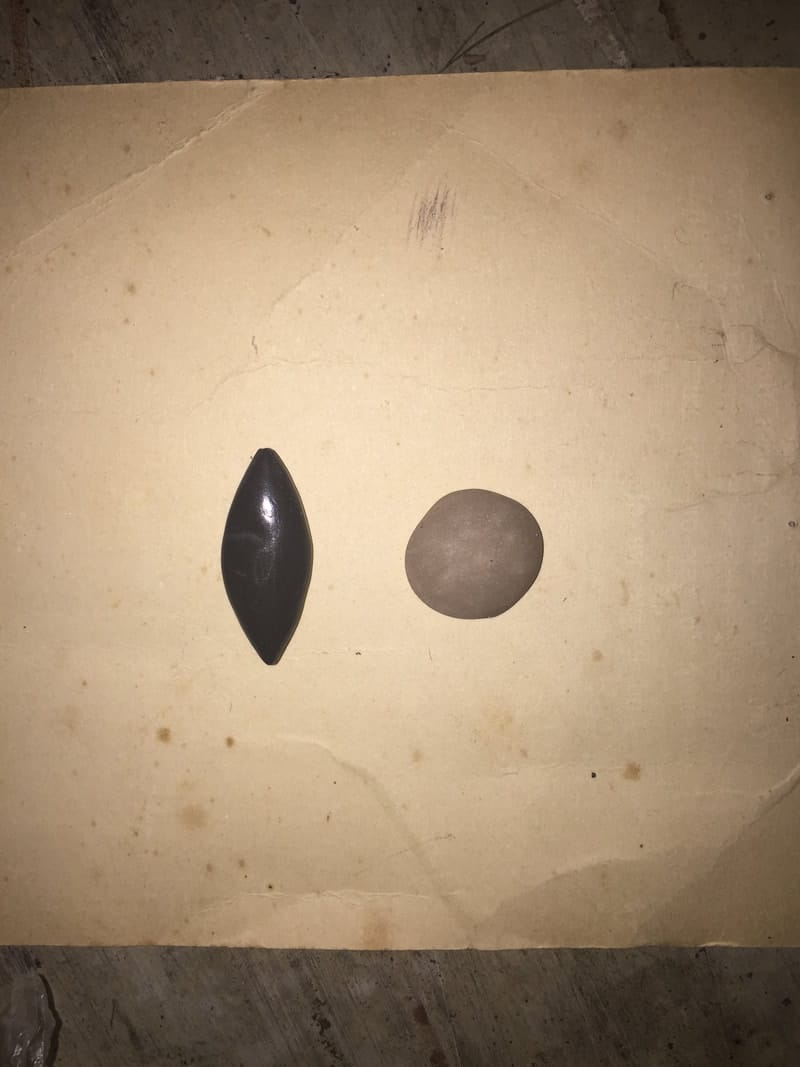Draconite, Serpent Stone
Stone of a Snakes Head, Snake Stone, Dragon Stone, Lapis DraconiteShe Huang (TCM)
 Ortus Sanitatis, Beck, 1517
Ortus Sanitatis, Beck, 1517 Two ‘Snake Stones’ bought by Adam in Rajasthan, India, in 2006. The one of the left was
Two ‘Snake Stones’ bought by Adam in Rajasthan, India, in 2006. The one of the left waspurchased from a member of the Naga (Snake) caste who showed the supposed skull of the King Cobra
it had been removed from and its tight fit within the Skull. The one on the right is from a streetside
‘Snake Charmer’ and is obviously manufactured.
Minerological name:
Lapis Draconite
Parts used:
Stone from the head of a snake, usually a King Cobra
As the term for Dragon and Snake were both sometimes represented by ‘Serpent’, it was called Draconite: ‘Dragon Stone’
Temperature & Taste:
Cold, dry.
Uses:
1. Clears Heat, Resists Poison:
-special function against Snake Poison, for which it was usually applied to the bite
-assumed to protect the holder from Snake Bites
-antidote to other Poisons and Venom
2. Magical Uses.
-accounted with protecting from Evil
-brings Wealth and Happiness (Traditional Western texts)
Comment:
1. This fantastical stone of Animal origin is mentioned in classical texts of both East and West. Its name Dragon stone goes back to a time when Dragons, Serpents and Snakes had blurry definitions. The Greek term ‘Drakon‘ referred to Serpent which can mean Snake, or the more ambiguous Dragon/Serpent of myth. As with other animal stones it is credited with Magical properties. However, even in modern-day India, the Stone is used by members of the Snake Cult, the Nagas, who still revere the Stone and believe it to heal snake bite if the stone is applied in time.
2. Note the name ‘Serpent Stone‘ is also used for fossil Ammonites (although not in traditional medical texts).
Cautions:
None noted
Main Preparations used:
- Extra Info
-
History
|
‘Take the stone which is called Draconites, from the Dragon’s head. And if the stone be drawn out from him alive, it is good against all Poisons, and he that beareth it on his left arm, shall overcome all his enemies’. (Albertus Magnus 13th C.) One of the earliest writings to mention the ‘Stone of a Serpents Head’ is noted in the 4th century Greek poem, Lithica. In it, the stone collected from the head of a snake is described as being black, round, rough, hard, furrowed with many wavy lines. They were used by Magi for their fight against various forces of Evil. ‘Found in the Brain of Serpents, but unless it is removed while they are alive, it will never become a precious stone, by the inbred malice of the animal who, conscious of death approaching, destroys the virtue of the stone. Therefore the head is removed from dragons while asleep, and thus the gem is secured … The color of the Draconite is white; it drives away all poisonous animals and cures envenomed bites. It is much affected by Eastern kings, for in the East there are many Serpents. Our own Chelydrus and Water-snake sometimes have gems in their heads, as I have myself seen; these may be called Draconites by analogy … I have seen pyramidal Draconites of this kind, both black and cerulean in color. Albertus testifies that he beheld a Draconite taken from a serpent like our Chelydrus, which was of an opaque black, surrounded by a pale ring, and having a very beautiful outline of a serpent on the surface. These species also drive away venomous animals and heal poisoned wounds’. (Lexicon of Alchemy) Discourse of the Travels of Two English Pilgrims (Timberlake, 1611) relayed the description of a fabulous jewel obtained from the head of a snake: ‘It grew, if we may credit the Indians, in the head of a monstrous serpent, whose retreat was by its brilliancy discovered. But a great number of snakes attending him, he being, I suppose by his diadem, of superior rank among the serpents, made it dangerous to attack him… Many were the attempts of the Indians, but all were frustrated, till a fellow more bold than the rest, casting himself in leather impenetrable to the bite of the serpent, or his guards, and watching a convenient opportunity, surprised and killed him, tearing the jewel from its head… That such a stone exists, I believe, having seen many of great beauty, but I cannot think it could answer all the ecomiums the Indians bestow upon it’. |
‘This stone being rubbed against another stone, yields a certain slime, which being drank in water by that person that has the poison in his body, powerfully drives it out’. Several tests were given to prove the genuineness: ‘The first is to place one in the mouth; it should cleave to the palate. The second test is to place one in a tumbler of water which should begin to seethe, and small bubbles will rise from the stone to the surface’. (Tavernier) There is a similar thing in Ayurveda known as Cobra Pearl (Bezoars were classed as types of Pearl). This Pearl is traditionally said to develop in the hood of King Cobras that are over 100 years old, and grows bigger as the snake grows older. The Cobra is said to have magical powers once it has this stone. It was said to be Moon-like, to have a bluish tint and be very radiant. It is kept in the mouth of the snake, and was believed the snake would die if it was removed from him. Believed to give wealth and fulfillment of all desires, and to rid negativity. One test for the genuineness of this is to put it in a Silver pot on the soil. If it is real, it is said to immediately cause it to rain. Traditional Chinese Medicine also has a version of Snake Bezoar. She Huang is a traditional remedy coming from a snake (according to Li Shen Chen), similar to Niu Huang which comes from the Cow. As it was said to be very rare, Iron Pyrite was used as its substitute. The special virtue of Snake Stone is against all Poison, but against Snake Venom in particular. It is placed on the part that has been bitten for a short while while it absorbs the poison, then drops off. It was said that two stones were required in serious cases, one to replace the first once it was saturated with venom. The stones were said to be relieved of their Poison if they were soaked in milk until it coagulated and became yellow-green in color. A report from an old addition of Lancet told of a Boer farmer who, possessing a Snake Stone, loaned it to his neighbors when their daughter was bitten by a snake. The stone was not applied for a number of hours after the bite, and this delay was said to have been the reason the wound did not heal properly. It should be noted here that the well known gemologist Kunz after examining a number of these stones, believed some to be Tabasheer. |
